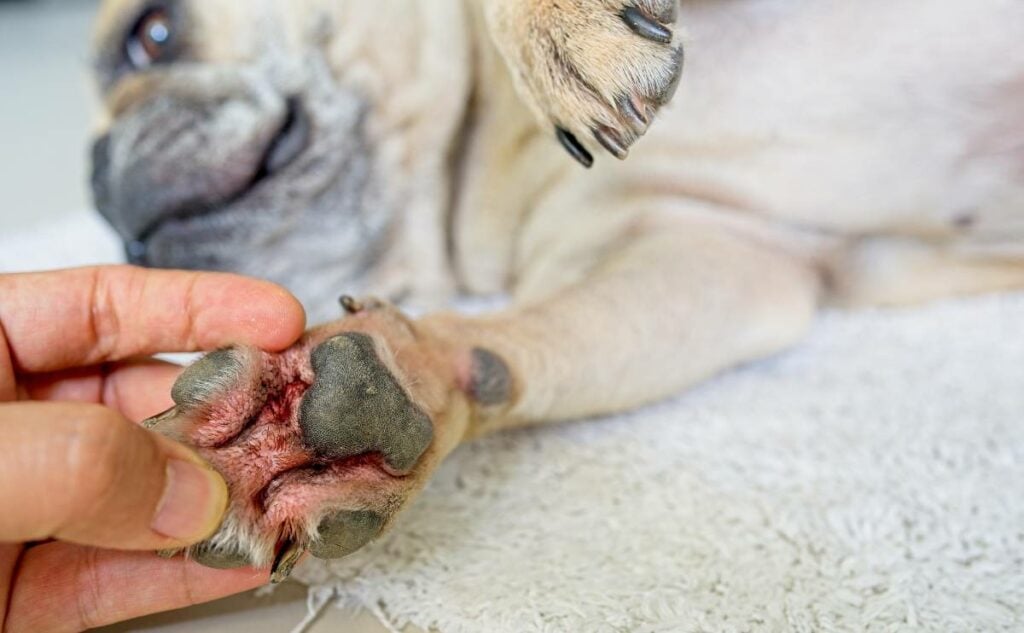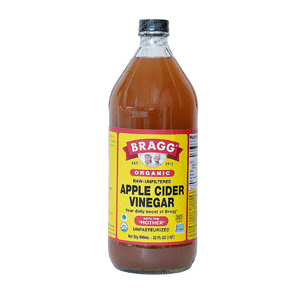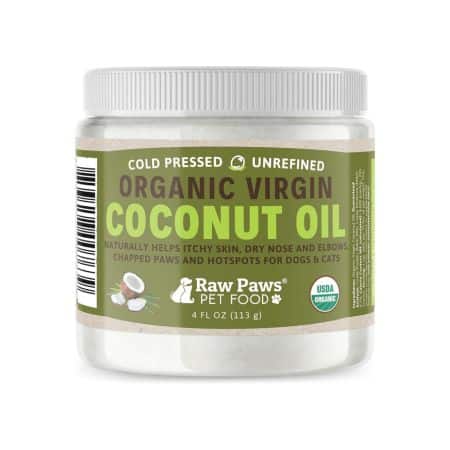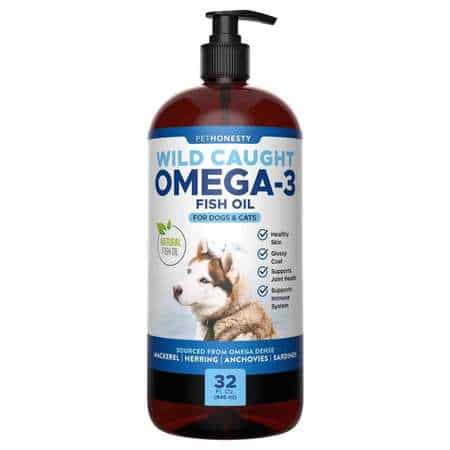

Yeast infections need treatment from your vet, which no home remedy can cure. But there are several ways you can soothe your pup’s discomfort at home in the meantime and hopefully prevent future occurrences. I explore what a yeast infection is, the different types, and the symptoms. I also look at natural yeast infection treatments for dogs you might already have at home and a few convenient products you can add to their diet, such as supplements and probiotics. So, let’s take a closer look.
Yeast infections are not considered a medical emergency, but they require veterinary treatment to clear up. They are very uncomfortable and can lead to further health problems, so if you suspect your dog has a yeast infection, you must contact your vet.
What Is A Yeast Infection & What Causes It?
Contents
Yeast is a natural fungus on all dogs’ skin, and a yeast infection results from a surplus of yeast. An overgrowth of yeast causes the skin to become red, scaly, and itchy, sometimes resulting in hair loss and further skin infections. Yeast infections also cause a distinctive and unpleasant odor, which most owners describe as cheesy or musty.
There are many yeast species, and Malassezia pachydermatis is the most common type that causes infections. Yeast overgrowth usually occurs in warm, moist environments, making infections more common in summer. However, there is usually an underlying factor, such as allergies, oily skin, weak immune system, hormonal imbalance, poor diet, skin injuries, and excessively moist skin. Some medications can suppress the immune system, which can cause repeated yeast infections.
Thankfully, yeast infections are not contagious but can cause discomfort and pain for your pooch. Check out our more in-depth guide on dog yeast infections to learn more.
3 Types & Signs Of A Yeast Infection
There are three types of yeast infections in dogs, and the symptoms vary. It’s important to understand what type of yeast infection they have so you can pick the best home remedy to treat it.
1. Skin Yeast Infection
A skin yeast infection, also known as yeast dermatitis, can occur anywhere on the skin. Because overgrowth of yeast usually occurs in warm and moist areas, it is more common in skin folds, armpits, or the genital region. Symptoms of yeast dermatitis include:
- Itchy skin
- Frequent licking or chewing
- Small, red bumps
- Brown discoloration
- Greasy hair
- Thickened skin
- Musty odor
2. Ear Yeast Infection
A yeast infection in the ears is also known as yeast otitis. An infection in the ear causes thick, dark discharge and a strong odor in the ear. Signs of yeast otitis include:
- Scratching ears
- Shaking their head
- Red, inflamed ear canals
- Thick, dark discharge
- Strong, musty odor
If you’re looking for a dog ear yeast infection home remedy, check out our guide on how to treat a dog ear infection without a vet.
3. Paw Yeast Infection
A yeast infection on the paws is usually caused by environmental allergens that the paws come into contact with. The most common allergens are grass or pollen. The symptoms of paw yeast infections include:
- Constant licking and chewing of the paws
- Moist, red areas on the pads and between the toes
- Brown discoloration of the skin and fur
How Vets Diagnose Yeast Infections & Traditional Treatments
Contact your vet for advice if you think your dog has a yeast infection. If they suspect an infection, they will examine your dog and collect a sample for analysis using a cotton swab or a microscope slide on the affected area. Yeast requires specific treatment, so they need to diagnose the infection before offering treatment. Yeast infections are commonly mistaken for other infections, such as pyoderma or hot spots, but your vet can correctly diagnose it.
If a yeast infection is present, they might prescribe a single treatment or combination of antifungal medication, medicated topical cream or ointment, antibiotics, and steroids. These items are only available by prescription, so it is essential to see your vet.
Did You Know?
Pet insurance may cover testing, treatment, and prescription medications for yeast infections that were not previous conditions. Reoccurring yeast infections and other chronic conditions, like allergies, can get quite expensive. Learn more about pet insurance coverage for dog allergies, and read our pet insurance reviews for more information.
Best Home Remedies For Yeast Infections In Dogs
Here are the most common home remedies for yeast infections, including natural yeast infection treatments for dogs. Please remember that these do not cure yeast infections; only a medicated prescription from the vet can do this. However, these home remedies can help reduce the chance of reoccurring yeast infections and soothe sore skin. Let’s take a look.
1. Apple Cider Vinegar

A popular home remedy is apple cider vinegar for yeast infections in dogs. It has a low pH and contains acetic acid, which helps prevent yeast from overgrowing. It’s important to dilute the vinegar. Otherwise, you can worsen the irritation. Dilute one part vinegar with one part water. Wipe or spray the solution over the infected area, but it shouldn’t be used in the ears, near the eyes, genital area, or any broken skin or open wound.
Some websites advise putting apple cider vinegar in dogs’ water or food bowls, but vets do not recommend this. It can cause gastrointestinal problems and enamel breakdown. Some owners use white vinegar, but apple cider vinegar contains antimicrobial properties and other beneficial bacteria.
2. Coconut Oil

Coconut oil is a natural moisturizer with antifungal properties that soothe irritated skin. If you haven’t already got it at home, you can buy coconut oil in most grocery or drugstores. Choosing unrefined or cold-pressed oil, which contains more active nutrients to soothe the skin, is important. Apply a thin layer of coconut oil directly onto the affected area. Too much can clog the pores and cause further problems. Most dogs love coconut oil, and although it is non-toxic, it can be very fattening and upset their tummy, so be careful they don’t lick it off.
If you’re concerned that your pup might lick the natural solution or topical ointment off and they don’t get on with dog cones, also known as the “cone of shame,” please visit our e-collar alternatives guide.
3. Oregano Essential Oil
Oregano essential oil has antimicrobial properties, which means it can prevent and fight yeast infections and other parasites such as worms. It contains carvacrol and thymol, which are natural antifungals. To treat yeast infections, add one or two drops of oregano essential oil to a teaspoon of olive or carrier oil. You could also add it to coconut oil for a moisturizing boost. Use a clean cotton swab or pad and gently wipe it over the infected area.
4. Probiotics

Probiotics have a wide range of benefits for your dog’s health, such as making and absorbing vitamins and minerals, keeping a strong immune system, and supporting a healthy gut. You can introduce probiotics to your dog’s diet in a few ways. Some owners add a scoop of natural yogurt to their dog’s bowls. The product needs to be high in live cultures with no added sugar or artificial sweeteners. Greek-style and kefir are also high-quality options that offer a range of digestive benefits as well as support their immune system. Another easy and convenient way is to choose a probiotic powder to add to their daily meals. Check out our best dog probiotics guide that can help with yeast overgrowth and prevention.
5. Fatty Acid Supplements

Ensuring your dog’s diet contains enough fatty acids is essential for many bodily functions and overall wellness. They also play a significant role in their immunity, skin, and coat health. Fatty acids also assist in reducing inflammation, soothing itchiness, and helping to balance hormones and bacteria, which play a huge role in yeast infections. A high-quality diet should include healthy omega-3 three fatty acids, but you can also add supplements to your pup’s diet. Learn more about how fish oil can benefit your dog.
Always speak to your vet if you’re considering adding supplements to your dog’s diet. Although they might benefit your pup’s health, they might also do more harm than good.
6. Change In Diet
If your dog is sensitive to certain ingredients in their diet, the allergen might be responsible for the yeast infection. Some of the most common food allergens are dairy products, chicken, beef, egg, corn, soy, wheat, and gluten. If your vet suspects that this is the cause, they might ask you to try an elimination diet to try and identify the ingredients. If you adjust their diet, you must change their dog food gradually and safely to avoid stomach upset. Limited-ingredient dog foods or those with a sole protein are another great way to eliminate certain ingredients. Watch this video that explains how exclusion diets work.
Always speak to your vet if you’re considering changing your dog’s diet.
7. Avoid Allergens
If your puppy is sensitive to environmental allergens such as grass or fleas, try to avoid them as much as possible. For example, if they are allergic to pollen or grass, try to walk in areas with less pollen or grass and limit walks to cooler parts of the day when the count is lower. Learn about dog seasonal allergies, along with the symptoms, treatments, and more. Using regular flea treatments can help canines with heightened allergies to flea bites. We have a guide on how to get rid of fleas and tips to prevent them.
If you suspect an allergen is causing yeast infections and want to investigate further, head to our guide on the best at-home allergy testing kits.
8. Frequent Baths
Bathing your dog regularly can help control and remove excess oils from their skin, which might be the cause of the yeast infection. Your vet might prescribe a medicated shampoo, which is the most effective. Over-the-counter shampoos can help prevent yeast infections in the long run. When bathing your dog, you need to find the balance between too little and too much. Too little and excess oils can build up, causing moisture, bacteria, and infection. But too much, and you can strip the skin of its natural oils, which also causes excess oil to build up. Speak to your vet about how often to wash your dog.
Frequently Asked Questions
We know some of our readers still have questions about dog yeast infection remedies and natural yeast infection treatments for dogs. If you don’t see your question, ask us in the comments below, and we’ll find out for you.
What’s The Best Yeast Infection Home Remedy For My Dog?
Understanding the cause of the yeast infection is crucial to finding the best yeast infection treatment for your dog. If your pup has dry skin, choose a home remedy containing moisturizing ingredients like coconut oil. If your dog might benefit from fatty acid supplements for their cognitive or joint health, adding them to your dog’s diet is a great idea. Remember, finding the best home remedy might take time and patience.
What Can I Give My Dog Orally For Yeast Infections?
In addition to natural oils that you can rub on the infected area to soothe the infection, you can also give them several oral supplements, such as fatty acids and probiotics. You can also change their diet to a high-quality option or one that doesn’t contain the allergen causing the infection. You should never give the home remedies for use on the skin orally.
How Long Do Yeast Infection Home Remedies Take To Work?
How long it takes to work depends on the remedy you have chosen. Some oils or solutions, such as coconut oil or apple cider vinegar, rubbed onto their problem area might offer instant relief from the itchiness. Whereas supplements or changes in diet can take several weeks before you can see a difference. It’s important to remember that a yeast infection needs medical treatment, and home remedies are to soothe irritation and manage and prevent reoccurring infections.
Does Your Dog Need A New Diet?
Speaking to your vet is wise if you think your dog’s diet is responsible for their reoccurring yeast infections. If they suspect allergens are the cause, in addition to adding natural yeast infection treatments, check out our guide on the best foods for dogs with allergies. If you want a higher-quality diet with natural ingredients, head to our fresh food options guide. Often, you can tailor these diets to your dog’s food intolerances.
Does your pup suffer from yeast infections? Do you use one of these natural home remedies, or maybe you have another that you think we should include in our list? Let us know in the comments below.
Why Trust Canine Journal?
Emma is a dog owner with over 20 years of experience. She has also worked as a professional dog walker and sitter for many years, caring for several dog breeds with different needs, including skin allergies and yeast infections. Emma dedicates countless hours researching the latest pet care, health, food, and training developments to keep her two best buddies and other doggy clients as happy and healthy as possible.